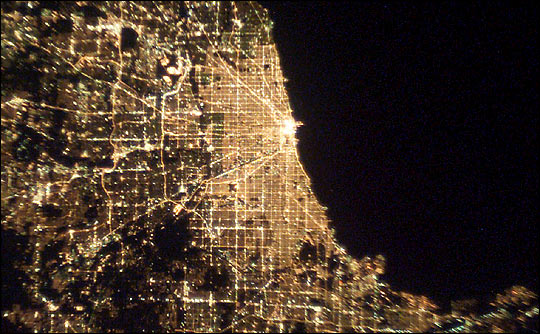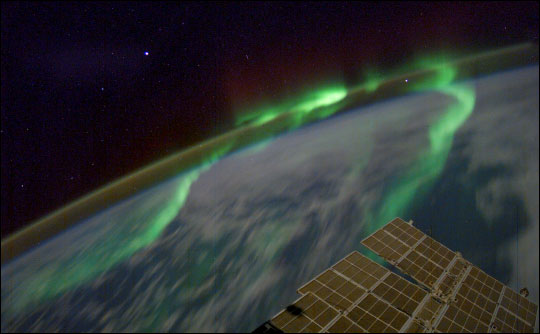

Over the Night Side |
|||
At night, you can easily see city lights. Larger cities are very easy to pick out, as well as sometimes the lights along major roads between them. As we round the southern tip of Africa, you can see the lights of Cape Town. City lights have a yellowish hue, which I think is due to the fact that most streetlights are sodium vapor lamps which have a yellowish tinge. We then head eastward over the southern Indian Ocean. |
|||
 | |||
At night, the dominant thing you see when you look down is thunderstorms. Lightning lights up the clouds in sometimes-spectacular displays. At any given time at night, especially over the tropics, you can see one or more lightning storms going on. The lightning flashes illuminate the clouds from within, and ripple through the storm systems. I enjoy turning off all the lights in the docking compartment, and watching thunderstorm systems at night through its sideward facing windows. The southern Indian Ocean is a great place to watch thunderstorms. |
This image of Chicago at night shows patterns of the city center and major roads along the coast of Lake Michigan. This kind of photography is technically challenging because it requires long exposures. Ed’s predecessor, Don Petit, was a pioneer in expanding the detail to which cities can be photographed from orbit (for example São Paulo, Brazil or Los Angeles) ISS007-E-16525 (October 7, 2003, 50 mm lens). | ||
|
As we near Australia, if you look towards the horizon southward you can see the aurora. The aurora look like glowing green curtains which move upwards from the top of the atmosphere. The curtains intersect the atmosphere in a curved line, which appears as a bright green line south of Australia. There are times when we actually fly through the aurora, and you can look downwards and see the green glow below you. Sometimes there are traces of red along with the predominant green. We’ve taken some time-lapse movies looking towards the horizon as we fly past the aurora. |
Although astronauts often comment on the appearance of lightning storms at night, they are very difficult to photograph. This rare image shows both green Aurora Borealis with a small band of red on top and bright spots in the clouds from lightning strikes while the shutter was open. It was taken by Don Petit on Expedition 6. ISS006-E-21386 (January 18, 2003, 400 mm lens) | ||
 | |||
The next part of this orbit takes us northeast across Australia. In the daytime, you can see the bright red color of the deserts of central Australia. At night, by the absence of lights you can see how few people live in this area. To the right is the coastal city of Sydney. The final part of this orbit crosses over the Great Barrier Reef and various South Pacific islands on our way back towards the equator. Most of the small islands dotting the South Pacific are ringed by coral reefs. The most striking thing about these reefs and small atolls is the bright almost iridescent aquamarine green color of the water. And that takes us to the finish of this orbit—total time around the world is 90 minutes. |
Expedition 6 crewmember Don Petit took this dramatic view of Red and Green Aurora Australis. The red aurora is just a hint of color extending above the green. The bright points of light are stars. The tip of one of the Space Station’s solar panels can be seen in the lower right of the image. ISS006-E-47215 (June 3, 2003, 50 mm lens) | ||
 | |||
If you want to see all the pictures that we have taken, go to the Gateway to Astronaut Photography of Earth. By using a digital camera, we can send the photos down each day on our communications network. This site includes access to the most complete collection of astronaut photographs of Earth—more than 475,000—including every photo of Earth that I have taken and sent home from orbit. This text was Ed Lu’s on-orbit journal entry for June 24, 2003. Julie Robinson and Mike Trenchard are with Lockheed Martin/Earth Observations Laboratory, Johnson Space Center. The International Space Station Program supports the laboratory to help astronauts take pictures of Earth that will be of the greatest value to scientists and the public, and to make those images freely available on the Internet. |
From space, the Great Barrier Reef looks like a string of iridescent aquamarine jewels around Cape Flattery, Australia. In this northern zone the barrier reef forms a nearly complete ribbon along the margin of the continental shelf. ISS007-E-14874 (January 18, 2003, 400 mm lens) | ||